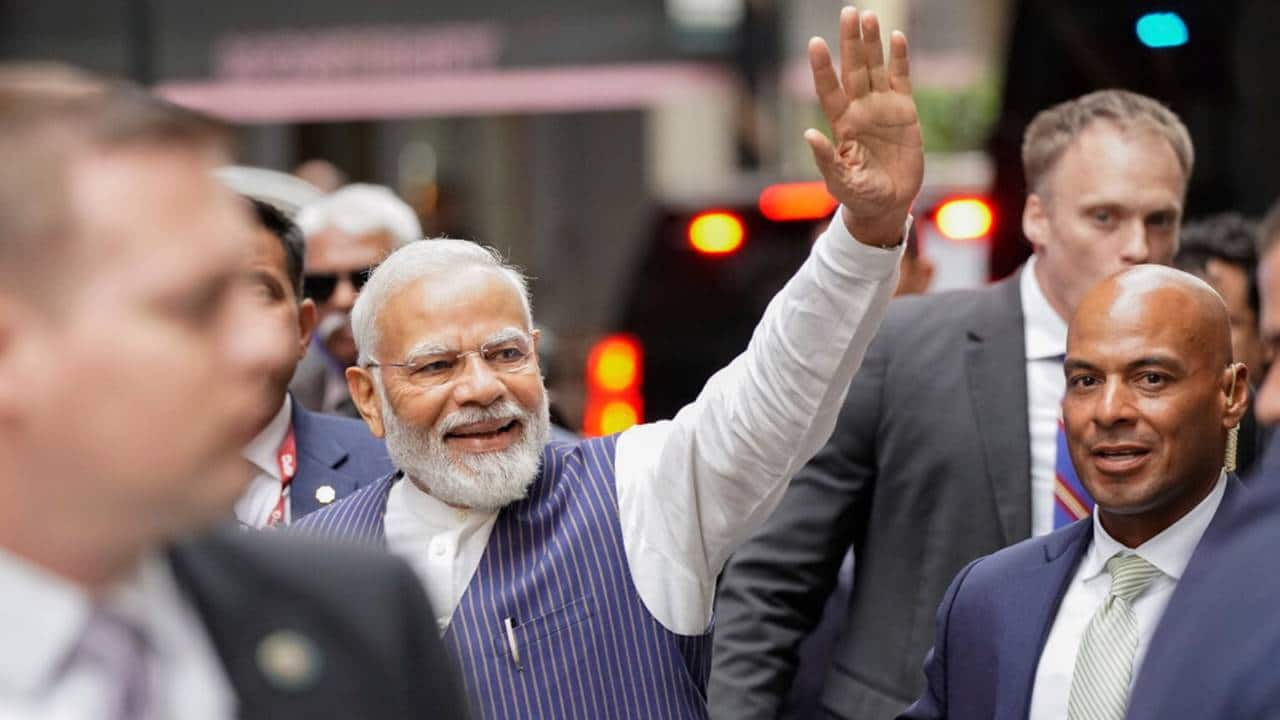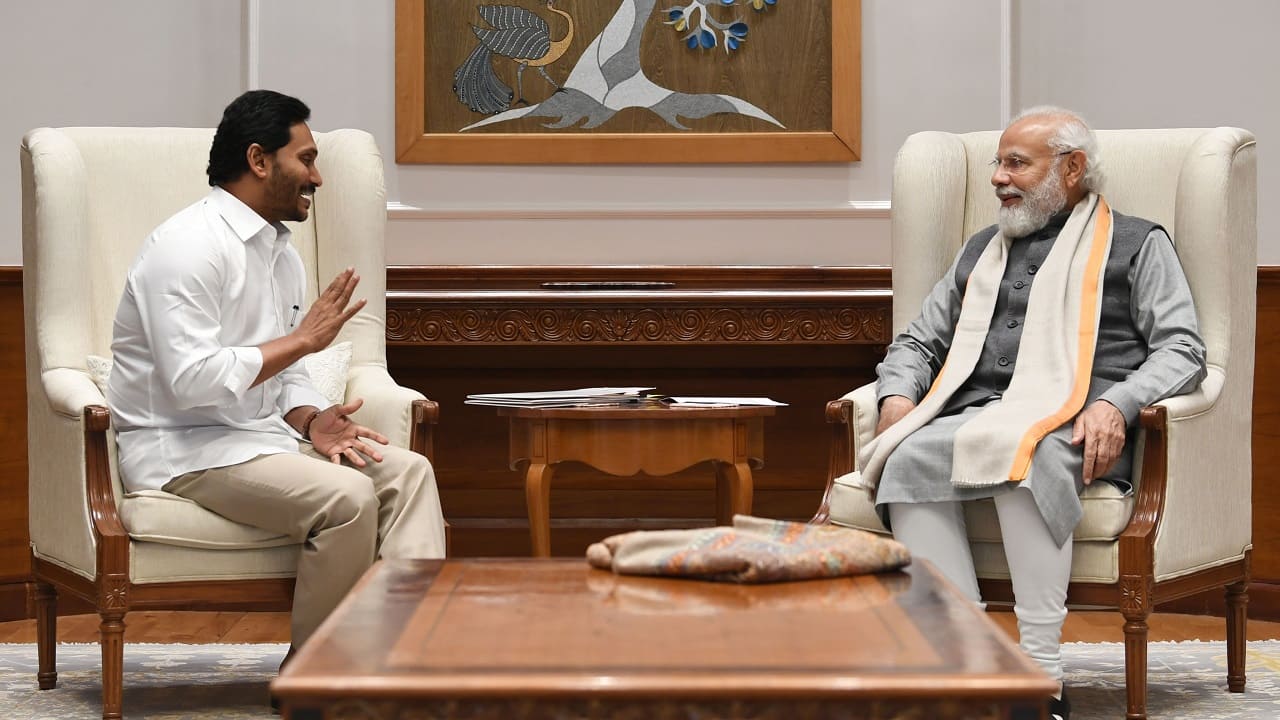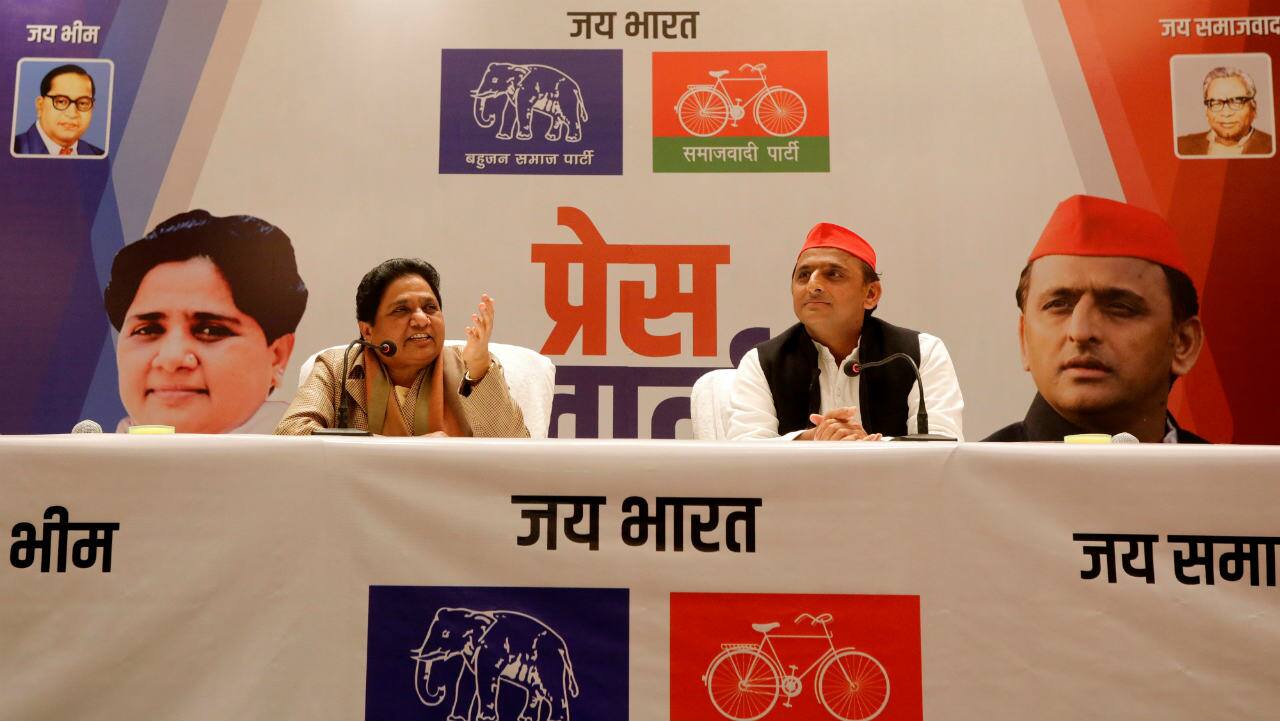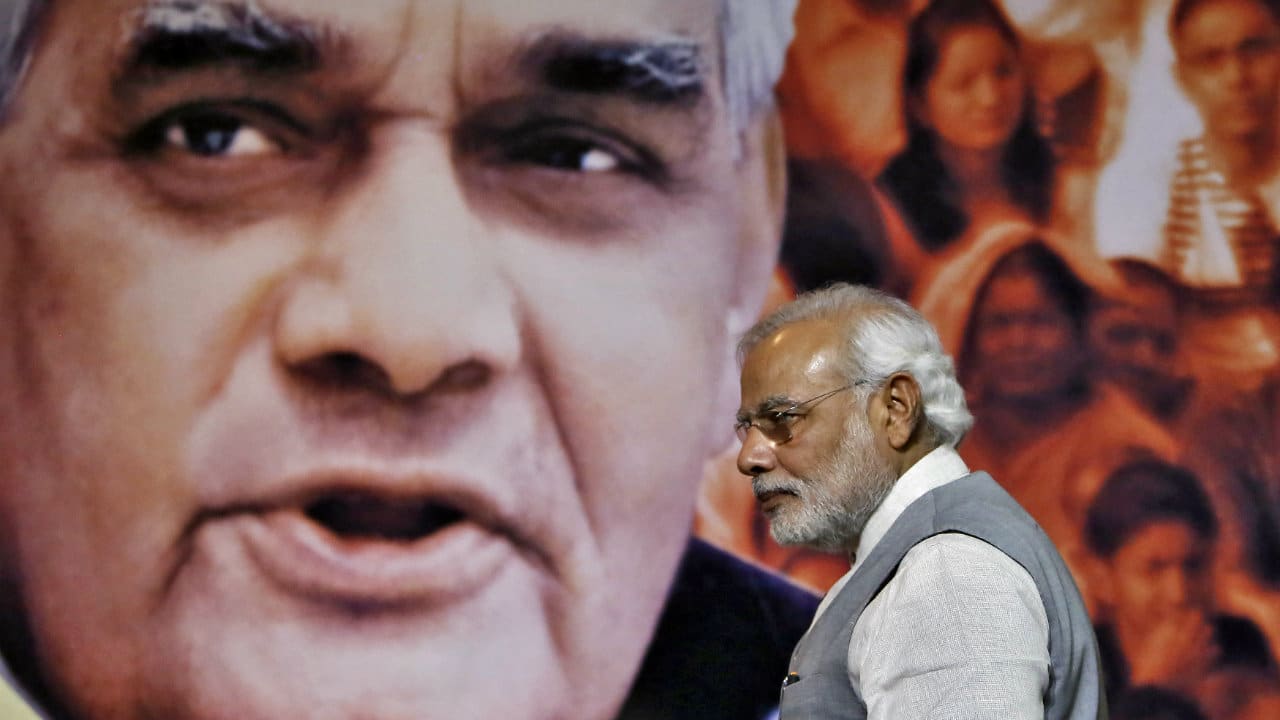



Battlelines were drawn as 26 opposition parties, who formalised their alliance in Bengaluru on July 18, said they have united to "safeguard the idea of India," "protect the Constitution," and "defeat hatred and violence.’’
The coalition, called the Indian National Democratic Inclusive Alliance, or INDIA, is seen as a challenge to Prime Minister Narendra Modi's brand of nationalist politics, ahead of the Lok Sabha (LS) polls next year.
Apart from the symbolism, political strength was also on display, as the 26 opposition parties include key national and regional players who are collectively in power in 10 states and one union territory. They have 142 of the 542 MPs in the Lok Sabha, and 98 of the 245 lawmakers in the Rajya Sabha (RS).
A united Opposition alone, however, may not be enough to go toe-to-toe against the ruling Bharatiya Janata Party (BJP), which has emerged as an electoral juggernaut, analysts say. Under Modi's reign, the saffron party has won two general elections, and expanded its rule from seven to 15 states over the last decade.
The National Democratic Alliance (NDA), the ruling coalition the BJP leads, has 332 MPs in the Lok Sabha (including 301 of the BJP alone), and 111 in the Rajya Sabha, including 92 of the BJP.
"The move to unite the opposition is a step in the right direction. But it is not easy to challenge a ruling party which is so electorally dominant, and has a popular prime minister," Sanjay Kumar, Professor and psephologist, Centre for the Study of Developing Societies (CSDS), told Moneycontrol.
 PM Modi is most popular among world leaders with 75% approval rating, a Morning Consult survey said in June 2023 (AP file photo)
PM Modi is most popular among world leaders with 75% approval rating, a Morning Consult survey said in June 2023 (AP file photo)This coalition will struggle if its campaign only targets Modi, he said, and added, "The appeal of such a campaign will be confined to their core supporters. In no way can this coalition win the elections without a positive narrative. This is because voters would want to know what alternative they are offering compared to the incumbent BJP."
A numbers game?Per the votes polled by these 26 parties in the 2019 LS elections, their combined share adds up to around 37 percent. This is nearly equal to the 37.36 percent votes the BJP polled in the last parliamentary polls.
While the combined vote share of the NDA stood at 45.03 percent, the alliance has lost key constituents since then. In Punjab, the Shiromani Akali Dal (SAD) has walked from the saffron fold, in Bihar the Janata Dal-United (JDU) has crossed over to the opposition, and the Shiv Sena, the BJP's key ally in Maharashtra, has been vertically split, with the faction headed by former chief minister Uddhav Thackeray supporting the anti-BJP group.
A section of poll pundits believe that a united opposition will prevent the division of non-BJP votes, and could possibly increase its cumulative vote share if anti-incumbency intensifies in the run-up to the elections.
The idea is to field only one opposition candidate in constituencies represented by the BJP, or where it is the main challenger. Although the INDIA alliance is yet to announce this formula, several of its constituents have hinted at this arrangement in separate statements to the press.
Congress MP and former union minister P Chidambaram was the most recent to voice this idea, noting that this kind of arrangement could be reached in a total of 450 seats. "In my view, if the non-BJP opposition parties get together, it is possible that in 450 seats we can field one common candidate against the BJP. But that is an aspiration," he said on May 30.
The united opposition could "possibly win 300-305 seats" and the BJP’s tally may get reduced to "around 235-240" if all non-BJP parties come together, Kumar wrote in a column for this publication in April, adding that the analysis is based on data from the 2019 elections.
This projection is based on the assumption that all the non-BJP parties will unite. This has not yet happened, as 11 parties who cumulatively account for 91 MPs (LS and RS combined), are currently neither aligned with the NDA nor the INDIA alliance.
Among others, this includes the YSR Congress Party (YSRCP), which had won 22 LS seats in 2019, and the Biju Janata Dal (BJD) had won 12. The Telangana Rashtra Samithi (now Bharat Rashtra Samithi), and the Bahujan Samaj Party (BSP) had won 9 seats each, and the Telugu Desam Party (TDP) three. The Shiromani Akali Dal (SAD) and the All India Majlis-e-Ittehadul Muslimeen (AIMIM) bagged two seats each, while the Rashtriya Loktantrik Party (RLP), the All India United Democratic Front (AIUDF), the Janata Dal (Secular) and SAD (Mann) got one seat each.
The combined vote share of the non-aligned parties in the last parliamentary elections stood at nearly 13 percent. These political groups may play a decisive role if they lend support to either INDIA or NDA. Among them, the two parties with the highest seats — the YSRCP and the BJD — are considered to be leaning towards the BJP as they have lent their support to the ruling party on key legislations.
 YSRCP chief and Andhra Pradesh CM Jagan Mohan Reddy with PM Modi (File image, PMO India)Transfer of votes a challenge?
YSRCP chief and Andhra Pradesh CM Jagan Mohan Reddy with PM Modi (File image, PMO India)Transfer of votes a challenge?While 2+2 = 4 in math, the same may not apply in politics. This may upend the opposition's calculus about outdoing the BJP in terms of collective vote share.
This was strikingly evident during the electoral battle for the 80 parliamentary seats in Uttar Pradesh (UP) in 2019. Traditional rivals Samajwadi Party (SP) and BSP had formed an alliance, which, on the basis of their past vote shares, was expected to score more than the BJP in the state.
The results, however, came as a surprise as the BJP ended up winning 64 of the 80 constituencies despite the SP-BSP alliance. Similarly, the Congress and the Janata Dal (Secular) had contested the 28 parliamentary seats of Karnataka in an alliance in 2019, but the BJP ended up winning 25 of those.
 BSP supremo Mayawati and SP chief Akhilesh Yadav had allied ahead of 2019 LS polls. However, they snapped the ties after failing to put up a strong performance (Reuters file image)
BSP supremo Mayawati and SP chief Akhilesh Yadav had allied ahead of 2019 LS polls. However, they snapped the ties after failing to put up a strong performance (Reuters file image)"There is an element of counter-polarisation. The BJP keeps saying `Ek Modi ko harane ke liye sab virodhi ek ho gaye’ (the opposition has ganged up to defeat Modi alone). This sounds catchy, and people begin questioning why the anti-BJP parties have come together in spite of such bitter rivalries in the past. The BJP benefitted from this kind of counter-polarisation in the last LS elections, particularly in UP, where they polled more than 50 percent of the votes in some constituencies," Kumar said.
At the same time, one must not forget that the cross-border strike at Balakot in response to the terror attack in Pulwama in February 2019 was a factor in the elections, he pointed out. The government's (apparent) strong response to the militant attack increased its popularity, "and may have pumped up the BJP's vote share by roughly 3-4 percent, which is enough for a ruling party to sweep the elections," the psephologist added.
Transfer of votes is also dependent on the cohesion between alliance partners. An ideological parity, along with a smooth tie-up, facilitates the consolidation of core voting blocks, experts say.
In case of the INDIA alliance, the negotiations are expected to be a long-drawn affair, and the Congress is likely to bargain hard with regional allies.
Some of questions that remain unanswered are whether the AAP and the Congress will agree to a seat-sharing arrangement in Delhi and Punjab, whether the SP and the Rashtriya Lok Dal (RLD) would agree to leave a considerable number of seats for the Congress in UP, and whether the TMC will make space for the Left Front and the Congress in West Bengal.
A couple of the allies have already hinted at playing hardball, with the AAP last month offering to withdraw from the electoral race in Madhya Pradesh and Rajasthan only if the Congress withdraws from Delhi and Punjab.
"Congress got zero seats in the 2015 and 2020 assembly elections in Delhi. If the Congress says it will not fight in Delhi and Punjab, then we will also not fight the elections in MP and Rajasthan," senior party leader Saurabh Bharadwaj said on June 15.
Similarly, Mamata Banerjee said on May 14 that the TMC was ready to support the Congress if it "sacrifices" its aspirations in West Bengal.
Policy document holds keyExperts are largely unanimous in their view that the opposition needs to clarify to the voters why it needs to dislodge the BJP, rather than running a campaign centred around Modi. A policy document, a vision statement, or a common minimum programme (CMP) will be the most effective way to promote their proposed socio-economic policies, they say.
The INDIA alliance should steer away from catch-all centrism as the BJP has already consolidated itself in that space, political scientist Suhas Palshikar argued in The Indian Express. "The media and the middle classes may disincentivise a sharp, cleavage-based position. But such a position is more likely to win over the Dalits, the Adivasis, small farmers, the urban poor and vast numbers of unorganised earners in the service sector," he wrote.
However, an argument against focusing more on the lower and weaker strata of society is that it may further alienate the middle class, which is already considered to be tilted towards the BJP.
A study published by the University of Pennsylvania showed 42 percent of the middle class in India's rural areas and towns, and 35 percent in cities, voted for the BJP and its allies in the 2019 elections. In contrast, the Congress and its coalition partners had got 26 percent of the middle class vote in rural areas, 25 percent in towns, and 30 percent in cities, per data shared in the research paper.
 Supporters of PM Modi lined up at a roadshow during his campaign trail (Reuters file image)
Supporters of PM Modi lined up at a roadshow during his campaign trail (Reuters file image)"Most of the regional parties have a greater support base among the lower strata of society. But they must realise that to defeat the BJP and Prime Minister Modi, they need to get additional votes. Where will these come from?", Kumar said, adding that the policy document should find appeal beyond the core supporters.
Political analyst Ravi Srivastava, however, believes that the INDIA coalition has a strong chance of winning over the section of the middle class that voted for the BJP in previous elections. "The policies of this government have alienated the middle class. They have to pay 30 percent income tax, and 28 percent GST. So, who are they earning for? A chunk of their salaries are going into the government coffers only," he said.
The middle class is "now feeling that the government is callous. It is buying oil on the cheap in the international market, but domestic fuel prices continue to remain above Rs 100. When the middle class buys a gas cylinder for Rs 1,100, it is bound to feel that it is suffering under this government," he added.
The Hindutva factorHindutva has been a recurrent theme in the BJP's electoral campaign, and is considered to have played a key role in the party's back-to-back assembly poll victories in UP, the expansion of its electoral footprint in Bihar, and the record mandate it won in Gujarat last year.
The Modi government's push towards fulfilling the BJP's core agendas — from the removal of Article 370, to the construction of the Ram Mandir, to the Uniform Civil Code (UCC) — has further reinforced the party's Hindutva identity.
The INDIA coalition, on the other hand, have reiterated their commitment to secularism. The joint resolution issued after the opposition meeting in Bengaluru said the 26 parties have united to defeat the "hatred and violence being manufactured against minorities", along with the "rising crimes against women, Dalits, tribals, and Kashmiri Pandits.’’
"Their poisonous campaign of hate has led to vicious violence against all those opposed to the ruling party and its divisive ideology," the resolution added, further noting that their fight is to save the "foundational pillars of the Constitution."
Will the opposition's mission resonate with a large section of the voters? Experts are divided. "Saving the Constitution, saving democracy, secularism, etc., is unlikely to find traction. A campaign around these subjects will not be enough to compel someone who voted for the BJP in 2019 to change his electoral choice next year," Kumar said.
Srivastava, however, pointed towards the recently held assembly polls in Karnataka, where the BJP had aggressively resorted to Hindutva politics but ended up losing the state. "Karnataka became a laboratory for Hindutva politics, with issues and controversies being raked up by the BJP and its allied outfits over halal, hijab, azaan, and Tipu Sultan. But that did not work in the polls. I feel that people, by and large, are rejecting this overdose of Hindutva," he said.
"There is a silent majority which is against this aggressive Hindutva. While it may find traction in some BJP strongholds like UP, Gujarat, and parts of Madhya Pradesh, I don't find any other state where this Hindutva factor will work for the BJP," added Srivastava, who is one of the co-founders of AAP but is not actively associated with it.
Modi versus who?One of the major drawbacks of the INDIA coalition is that it remains faceless for now, and is unlikely to project a prime ministerial candidate ahead of the Lok Sabha polls, analysts say.
The opposition is caught in a dilemma. Without a prospective PM, the alliance may fall into the "Modi versus who?" trap; with a face, they may put up a leader who is nowhere near Modi in appeal and popularity.
The "Modi versus who?" question was extensively used by the BJP and its allies in 2019, when none of the opposition parties had projected a PM candidate.
"It is very difficult to put up a candidate who can square off against Modi. That is the reason why the INDIA alliance is absolutely silent on this issue. But what they may resort to is shadow-boxing against Modi. In the days to come, we can expect this opposition coalition to attack the prime minister on issues such as inflation, unemployment, crony capitalism, and mismanagement of the economy, which in turn may dent Modi's popularity," Srivastava said.
 PM Modi walks in front of a picture of former prime minister Atal Bihari Vajpayee (Reuters file image)
PM Modi walks in front of a picture of former prime minister Atal Bihari Vajpayee (Reuters file image)The opposition can derive solace from the fact that the erstwhile United Progressive Alliance had, defying pre-poll predictions, defeated the BJP-led NDA in 2004 without clearly projecting a challenger to replace the then PM Atal Bihari Vajpayee.
Can the INDIA coalition repeat history 20 years later? Watch this space…
Discover the latest Business News, Sensex, and Nifty updates. Obtain Personal Finance insights, tax queries, and expert opinions on Moneycontrol or download the Moneycontrol App to stay updated!
Find the best of Al News in one place, specially curated for you every weekend.
Stay on top of the latest tech trends and biggest startup news.